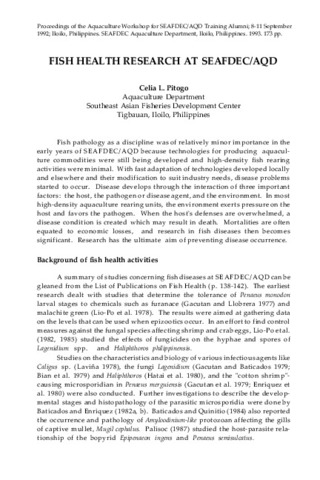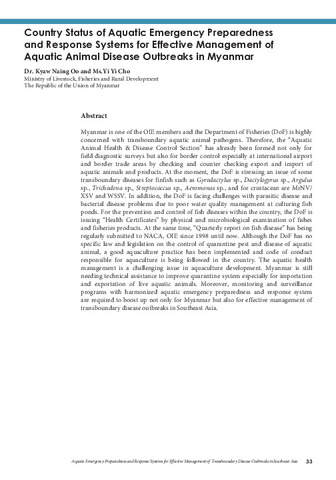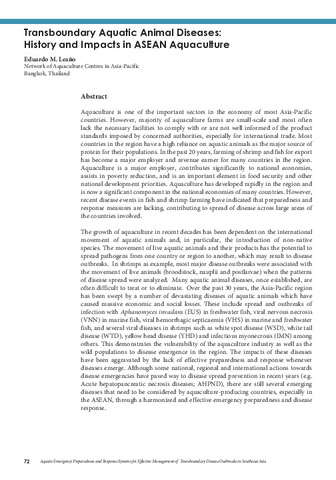Fish health research at SEAFDEC/AQD
- Global styles
- MLA
- Vancouver
- Elsevier - Harvard
- APA
- Help
Share
Abstract
Fish pathology as a discipline was of relatively minor importance in the early years of SEAFDEC/AQD because technologies for producing aquaculture commodities were still being developed and high-density fish rearing activities were minimal. With fast adaptation of technologies developed locally and elsewhere and their modification to suit industry needs, disease problems started to occur. Disease develops through the interaction of three important factors: the host, the pathogen or disease agent, and the environment. In most high-density aquaculture rearing units, the environment exerts pressure on the host and favors the pathogen. When the host's defenses are overwhelmed, a disease condition is created which may result in death. Mortalities are often equated to economic losses, and research in fish diseases then becomes significant. Research has the ultimate aim of preventing disease occurrence.
Suggested Citation
Lavilla-Pitogo, C. R. (1993). Fish health research at SEAFDEC/AQD. In C. T. Villegas, M. T. Castaños, & R. B. Lacierda (Eds.), Proceedings of the Aquaculture Workshop for SEAFDEC/AQD Training Alumni, 8-11 September 1992, Iloilo, Philippines (pp. 134-142). Tigbauan, Iloilo, Philippines: Aquaculture Department, Southeast Asian Fisheries Development Center.
Type
Conference paperISBN
9718511253
Related items
Showing items related by title, author, creator and subject.
-
Country status of aquatic emergency preparedness and response systems for effective management of aquatic animal disease outbreaks in Myanmar
Oo, Kyaw Naing; Cho, Yi Yi (Aquaculture Department, Southeast Asian Fisheries Development Center, 2019)Myanmar is one of the OIE members and the Department of Fisheries (DoF) is highly concerned with transboundary aquatic animal pathogens. Therefore, the Aquatic Animal Health & Disease Control Section has already been ... -
Transboundary aquatic animal diseases: History and impacts in ASEAN aquaculture
Leaño, Eduardo M. (Aquaculture Department, Southeast Asian Fisheries Development Center, 2019)Aquaculture is one of the important sectors in the economy of most Asia-Pacific countries. However, majority of aquaculture farms are small-scale and most often lack the necessary facilities to comply with or are not well ... -
Emergency response to emerging diseases: TiLV in tilapia
Senapin, Saengchan (Aquaculture Department, Southeast Asian Fisheries Development Center, 2019)Tilapia lake virus (TiLV) is a novel RNA virus resembling Orthomyxovirus. It has been recently re-classified to Tilapia tilapinevirus species, under Tilapinevirus genus, Amnoonviridae family (ICTV, 2018). Since the first ...






